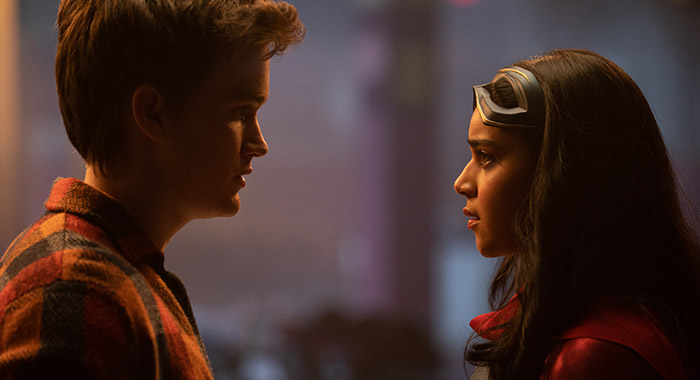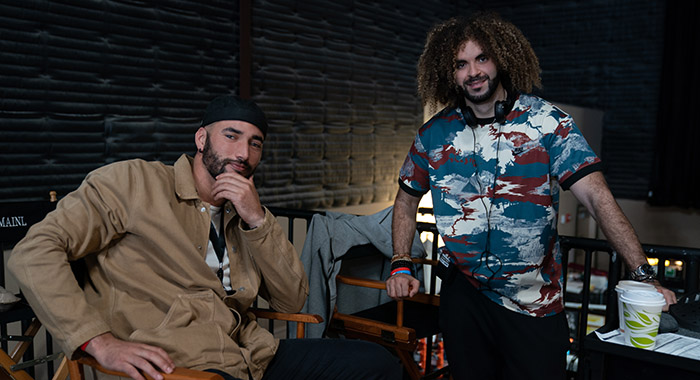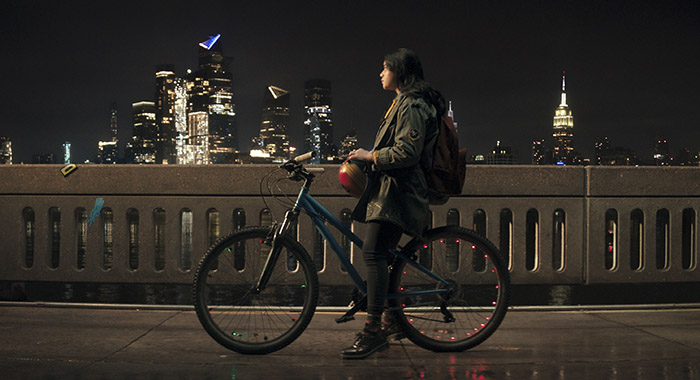TAGGED AS: Disney, Marvel, superhero, television, TV

(Photo by Daniel McFadden/Marvel Studios)
The finale of Ms. Marvel offered viewers their first look at Kamala Khan (Iman Vellani) in her full-fledged Ms. Marvel form – complete with costume and name. The episode also offered a somewhat unexpected take on her “embiggen” catchphrase. Unlike the shout it often becomes in the comics or animation, it was presented as a quieter utterance ahead of a more explosive, physical moment.
Rotten Tomatoes had the chance to talk to executive producers and finale directors Adil El Arbi and Bilall Fallah (Bad Boys for Life) about realizing the moment and how it grew out of their prep work to convert Kamala’s powers from the shape-shifting in the comics to the hard-light manipulation of the television show.
El Arbi and Fallah also talk about directing a raid on the high school in light of U.S. school shootings and gun control issues, whether or not the animated X-Men theme played during a key moment, the haram (forbidden) and halal (permissible) baseball caps worn by Bruno (Matt Lintz) and Kamran (Rish Shah), and if Kamala’s unique point of view will continue as she ventures out in the Marvel Cinematic Universe.

(Photo by Daniel McFadden/Marvel Studios)
Erik Amaya for Rotten Tomatoes: It’s interesting the way Kamala utters the phrase “embiggen” in the end. Was it always meant to be a quieter prelude to what happens afterward?
Adil El Arbi (pictured right): For us, when we had the script, the powers were already described differently, but it was not a lot of info on that. It was just described as hard light and, obviously, we loved the powers that were originally in the comic, so we wanted to do an adaptation of that and what better way them to do it in the finale where we wanted to actually do our version of the “embiggen.” Our VFX people [and supervisor] Nordin Rahhali designed that embiggen size of [the hard light projection]. We were thinking, OK, how do we do this that it’s still in a meaningful way and an emotional way and in a moment where she’s forced to go to the next level?
That’s why it seemed appropriate that this is the moment she takes all the courage that she has. It’s really like she grew up as a person, as a superhero. And that’s why she’s like, OK, I got to do what I got to do. And that’s how that moment of “embiggen” came to be, which means that probably in the future, the “embiggen” will be then more like a shout or something. But at that moment, it needs to be very emotional.
Read also: Ms. Marvel Finale Ties a Bow Around Kamala’s Origin Story, But Leaves Major Questions
Almost like a centering moment for her?
El Arbi: Yeah. Sometimes it’s like when you are fighting in the ring in boxing, you’re down on the ground, you got to pull up everything together. It’s through your teeth that you’re going to say that: “Embiggen.”
Considering the difference in Kamala’s powers, creating a good stretchy effect — like her embiggened hand in the comics — is one of the toughest things to do in visual effects. Did you ever do any tests with it or was the hard light power there from the jump?
Bilall Fallah (pictured above left): It was there from the jump when we started. It was already clear that Kevin Feige didn’t want to make literally a translation of the comic book and really wanted to do an adaptation. And that’s also story-wise, but also power-wise. We started with the hard light idea and that’s how we developed it. CGI-wise, stretching powers are always a challenge. That’s always difficult, because you are always flirting with that uncanny valley aspect. So I’m very curious to see how they will evolve it in the coming year with Mr. Fantastic [in Fantastic Four].

(Photo by Daniel McFadden/Marvel Studios)
On to something a little bit more serious with Damage Control raiding of the high school. We’ve reached a point in the U.S. where you can’t really depict that scene and it not be released around some sort of real life tragedy. So when you see something like that in the script, how do you go about doing maintaining the tension of the story while also remain sensitive to the what is going on out there in the real world?
Fallah: I think that we and Marvel tried to be as careful as possible in the sense that we didn’t want to do a high school during the day with a bunch of kids [in the halls]. It was a very specific time and place where it would be at night and it would be the intention [of Damage Control] to just catch those kids. So, it was obviously a very tricky situation to keep it still interesting and still cool. That’s the thing that we were thinking about it as filmmakers, but Marvel was really very supportive of that. And I think that, eventually, the audience understood that this is just fiction and fantasy and also quite different from those real-life tragedies.

(Photo by ©Marvel Studios 2022. All Rights Reserved.)
Going back to adaptation for a moment, how important was it to include that lamppost shot?
Fallah: I think it’s the most iconic image of the comic books. So, we were like, ‘This has to be on the right moment.’ So we had that decision that it’s going to be one of the last images you see in the whole show and that it tells a lot. It’s her sitting on a lamppost from New Jersey, looking at New York. New Jersey, the little sister, and New York, the big sister or the big brother. And that image was really from the start [destined] to be the last one. When we shot that I think the whole crew felt the magic and also had goosebumps. This is that image we’re going to make for real now.
Just to clarify, that is the 1997 animated X-Men theme playing after Bruno says “mutation,” right?
El Arbi: It is there.
Fallah: It’s there.
El Arbi: When we read it in the script, we were like, ‘Oh, that’s for reals?’ And I got instructions to use that little track, but we didn’t get any more information than that.
Interesting. It is the best X-Men theme ever.
El Arbi: It is. It’s iconic stuff.

(Photo by Marvel Studios)
So now that Kamala’s world is the one she always wanted to be part of, will the more fanciful visuals like the chalkboard drawings in the finale continue or do you think that, thematically, it might disappear?
El Arbi: Well, if it’s up to us, we want to do more of that.
Fallah: Even more.
El Arbi: We wanted to do that throughout the whole show, everywhere, every five seconds. It’s great fun to do that. It’s something that really shows her dream world and it made the show so very distinctive. If, one day, we would have the chance to do a Ms. Marvel movie or something like that, we would go loco on that aspect.
The haram and halal baseball caps worn by Bruno and Kamran are such great visual jokes. How early did that appear in the discussions and how hard was it to actually get them made?
El Arbi: No. I think it was pretty early. Was it [Ms. Marvel co-creator] Sana Amanat’s idea?
Fallah: Yeah.
El Arbi: I think that these hats actually exist, from what I heard. So, they might have just even bought existing hats, who knows? But it was pretty dope.
Fallah: Yeah. We love visual humor. That’s perfect. Let’s put the hats on, no words, and it’s pure comedy.
El Arbi: We learned from the great Jerry Bruckheimer that funny is money. So, wherever we can sprinkle some of that humor, we try to do our best.
Fallah: I was just thinking Bruno or who’s going to wear halal and who’s going to wear haram?
The Karachi episodes were shot in such an inviting way. Were you involved at all in the look they had?
El Arbi: The director of those episodes, Sharmeen Obaid-Chinoy, is from Karachi. She lives there, and we always thought it should have that vibrancy; the same way that our origin is from Morocco and we want to have that aspect where it feels alive and it feels real and authentic. I think that she made a really great job in achieving that recreation of her hometown. And that’s why it feels so real. And obviously she was also in Karachi, so she did some drive-by shots of the real city sprinkled throughout the show. I think that made sure that it looked and felt real, because we had the best director possible for those episodes.

(Photo by Marvel Studios)
Did you feel the same attention needed to be paid to the Jersey City you created in Atlanta?
El Arbi: Yes.
Fallah: For us, it’s like the city is a character itself. When you see New York in Spike Lee movies, New York is like a character on its own. That’s what we wanted to do with New Jersey and really show all those different worlds and see the Desi street and all this vibrancy that’s in a city that we love and that’s part of the world of Kamala. So having that colorful and dynamic and authentic street/urban feeling was really important for us to translate. And the good thing is that Atlanta is not that different. For Bad Boys for Life, we had to make Atlanta look like Miami. That was a much more difficult mission, but with this it was much easier. Also, having a lot of people that are from New Jersey [on the crew] really helped us create that authenticity that really has the New Jersey character.
![]() 98%
Ms. Marvel: Season 1
(2022)
is now streaming in its entirety on Disney+.
98%
Ms. Marvel: Season 1
(2022)
is now streaming in its entirety on Disney+.